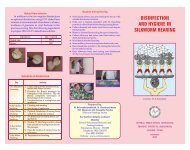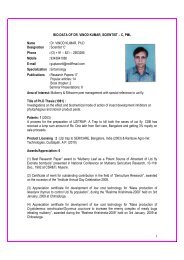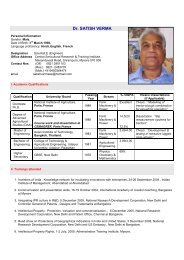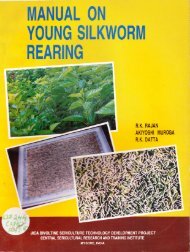Silkworm
A Treatise on the Acid Treatment of Silkworm Eggs - Central ...
A Treatise on the Acid Treatment of Silkworm Eggs - Central ...
You also want an ePaper? Increase the reach of your titles
YUMPU automatically turns print PDFs into web optimized ePapers that Google loves.
for a maximum period ol 5 days at 5oc to 7 days at 2.5"c, at a specific age. The optimum age for<br />
relrigeration has been found to be between 16 and 22 hours after ovipositionl rne eggs are essentially<br />
passed through an intermediate temperature of 15oc for 2 hours. simiiarry aitr,r. tir* or release, the eggs<br />
are passed through '15"C and 25oC for a duration of 2 hours each bef ore sublecting to acid treatment. This<br />
exercise prevents the eggs from experiencing shock due to sudc]en temperature""n"ng, and helps in restoring<br />
the normal physiology.<br />
Postponement should never be resorted to forthe eggs which have attained some degree of pigmentation'<br />
lt may be implemented only when it is possible t6 mainrain RH of 75% + 5% and the different<br />
temperaturespreciselytotherequisitelevels. ltis advantageousio,rhengrainageoperationsolaparticular<br />
lot with special relevance to moth exarnination are under pr6;;ss. After veri{ying the moth examination<br />
results' the lreatment can be conducted. Postponement can"also be resoded to for the f irst and second<br />
day oviposited layings of a batch which are generaily ress in nurnber.<br />
Cold storage of acid treated eggs<br />
The acid treated diapausing eggs, due to prevention of diapause , behave similar to non-diapausing<br />
eggs' Hence, lhey are also referred lo as artificial non-diapauJ,,<br />
"ggr.<br />
such eggs can be stored at Soc<br />
for a maximum duration of three weeks. Preservation beyond tnis may result in irregular hatching, as the<br />
embryo cannot withstand along span of cold storage. ih, prrr.raiion of eggs is arranged when the<br />
embryo has attained the longest embryonic stage rinicrr is generatty accomplished between 50 and 60<br />
hours of development.<br />
Acid treatment for diapause eggs after chiiling<br />
The distinct advantage of diapausing eggs is that they can be made to hatch in any part of the year.<br />
This is accomplished by two different metnooJ - (a) for imrnediate hatclring by blocking the diapause and<br />
(b) for delayed hatching by its termination.<br />
The hot and cold acid.treatments, popularly referred lo as comnton methods of acid treatment are<br />
basically the tools for blocking or preventing diapause. The acid treatment of the eggs, before diapause<br />
initiation, inhibits certain activities and induces a score of biochemical reactiJn"s which ultimately<br />
translorms them into artificial non_diapause eggs.<br />
on the other hand, where diapause is partially or totatly estabtished, it has to be eventuaily terminated'<br />
ln silkworm eEgs, diapause termination is achieved oy exposing the eggs to low temperature of<br />
5oc or 2'5'c {artificiat.overwintering). Effective termination of diapause can only be accomplished when<br />
the eggs experience low temperature stimulus for a minimum of go days. suin cnircaeggs Eive good<br />
and uniform hatching' on the contrary, inadequate exposure cannot activate lhe diapause eggs<br />
completely and in such cases, hatching is irregular and poor- lt is {or such eggs that a specific acid<br />
treatment is suppremented to bring about unifrdm and good hatching.<br />
The eggs preserved at high temperatlre (25"c) for 30-35 hours and chilled at 5oc for 30-40 days<br />
(popularlyreferredto asshorttermchiitinglor+0-50hoursotdeggschiiledfor35-50days(poputarlyknown<br />
as long term chiiling) are subjected to th-is acid treatment.<br />
Under this method of lreatment, HCI of specif ic gravity 1 .10 (20%concentration) is heated to 47.8,c<br />
and the eggs are soaked for 4-5, 5-6 and o-7 mirutes ior crrinese, Japanese and European races<br />
respectively' However, barring these parameters, the normal procedure described earlier, is lollowed to<br />
acid treat the chilled eggs.<br />
Precautions :<br />
26<br />
1' while shifting the eggs from high temperature (25"c) to low temperature (5"c) or vice-versa,<br />
have to<br />
they<br />
be essentially passed through an intermediate temperature of 1Soc for about 3 hours to<br />
similarly, prior to acid tieatment, eggs f rom 15"c are transferred to 2soc and kept for<br />
ilj:*"tn'<br />
2 T.he eggs released from 5oC have to be acid treated within six hours. This is so because the serosal<br />
pigmentstartsspreadinguniformlyinthesersoalcells. oncethespreadofthepigmentiscomplete,<br />
the impact of acicl treatment gets nullified.




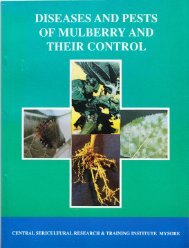

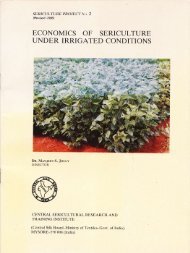
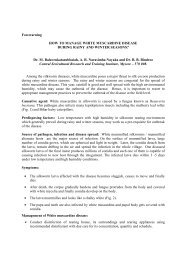
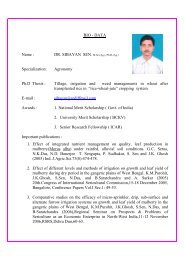
![E}A]\GALORE](https://img.yumpu.com/54052619/1/190x260/eagalore.jpg?quality=85)
